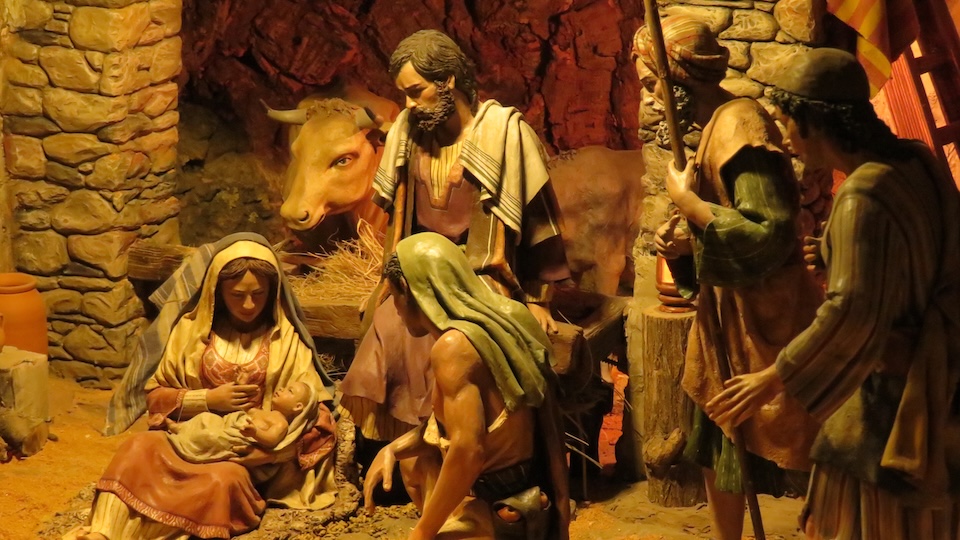

Pope’s General Audience – December 20, 2023
Pope Francis
Wednesday, December 20, 2023

Photo by Omar Trejo on Cathopic.
During today's General Audience, Pope Francis reflected on the intent of St. Francis' living Nativity in Greccio. He said that "the Nativity scene is like a small well from which to draw the nearness of God, the source of hope and joy." Read the full text of his address below:Dear brothers and sisters, good morning! Eight hundred years ago, at Christmas in 1223, Saint Francis organized the living Nativity scene in Greccio. While Nativity scenes are being prepared or completed in homes and other places, it is good for us to rediscover their origins. How did the crib come about? What was St. Francis’ intention? He said this: “I want to depict the Child born in Bethlehem, and in some way see with the eyes of the body the hardships in which He found Himself for want of the things necessary for an infant: how He was laid in a manger and how He lay on the straw between the ox and the donkey” (Tommaso da Celano, Vita prima, XXX, 84: FF 468). Francis doesn’t desire to create a beautiful work of art, but through the Nativity scene, to provoke amazement at the extreme humility of the Lord, at the hardships He suffered, for love of us, in the poor grotto of Bethlehem. In fact, the biographer of the Saint of Assisi notes, “In that moving scene, evangelical simplicity shines forth, poverty is praised, humility is related. And Greccio has become like a new Bethlehem” (ibid., 85). I’ve emphasized one word, “amazement.” And this is important. If we Christians look at the crib as a beautiful thing, as something historical, even religious, and pray- this is not enough. Before the mystery of the Incarnation of the Word, before the birth of Jesus, we need this religious attitude of amazement. If I, in the face of the mysteries do not come to this amazement, my faith is simply superficial; a “computational faith.” Do not forget this. And one characteristic of the Nativity scene is that it was conceived as a school of sobriety. And this has a great deal to say to us. Today, in fact, the risk of losing sight of what counts in life is great and paradoxically increases precisely at Christmas — the mentality of Christmas is changed — immersed in a consumerism that corrodes its meaning. The consumerism of Christmas. It's true, that you want to give presents, that’s fine, that’s one way, but that frenzy to go shopping that draws attention elsewhere and there is not that sobriety of Christmas. Let us look at the crib: that awe before the crib. Sometimes there is no inner space for astonishment, but only to organise parties, to have parties. And the Nativity scene was created to bring us back to what matters: to God Who comes to dwell among us. That is why it is important to look at the Nativity scene, because it helps us understand what matters and also the social relationships of Jesus in that moment: the family, Joseph and Mary; and loved ones, the shepherds. People before things. And often we put things ahead of people. This doesn’t work. But the Nativity scene of Greccio, in addition to sobriety that makes us see, speaks also of joy. Because joy is a different from having fun. But having fun is not a bad thing if it is done on good roads. It is not a bad thing, it is a human thing. But joy is deeper still. More human. And sometimes there is a temptation to have fun without joy; to have fun by making noise, but the joy is not there. It is a bit like the figure of the clown, who laughs and laughs, and makes people laugh, but the heart is sad. Joy is the root of good Christmas fun. And about sobriety, the chronicle from back in the day says, “And the day of gladness comes, the time of rejoicing! [...] Francis [...] is radiant [...]. The people flocked and rejoiced with a joy they had never tasted before [...]. Everyone returned home full of ineffable joy" (Vita prima, XXX, 85-86: FF 469-470). Sobriety, amazement, leads you to joy, true joy, not artificial joy. But where did this Christmas joy come from? Certainly not from having brought home presents or having experienced lavish celebrations. No, it was the joy that overflows from the heart when one tangibly touches the nearness of Jesus, the tenderness of God, who does not leave us alone, but consoles us [translator’s note: stands with (con) those who are alone (soli)]. Closeness, tenderness, and compassion, such are the three attitudes of God. And looking at the Nativity scene, praying before the Nativity scene, we can experience these things of the Lord that help us in every day life. Dear brothers and sisters, the Nativity scene is like a small well from which to draw the nearness of God, the source of hope and joy. The Nativity scene is like a living Gospel, a domestic Gospel. Like the well in the Bible, it is the place of encounter where we bring to Jesus the expectations and worries of life, just as the shepherds of Bethlehem and the people of Greccio did. Bringing to Jesus the expectations and the worries of life. If, before the Nativity scene, we entrust to Jesus all we hold dear, we too will experience “great joy” (Matthew 2:10), a joy that comes precisely from contemplation, from the spirit of amazement with which I go to contemplate these mysteries. Let us go before the Nativity scene. Look, everyone, and allow your heart to feel something within. Thank you. Text courtesy of Libreria Editrice Vaticana
Related Articles:
<<
SUPPORT LABEL
$50
$100
$150
$250
OTHER AMOUNT
DONATE
Receive our newsletters
Stay Connected
Receive our newsletters

Stay Connected









